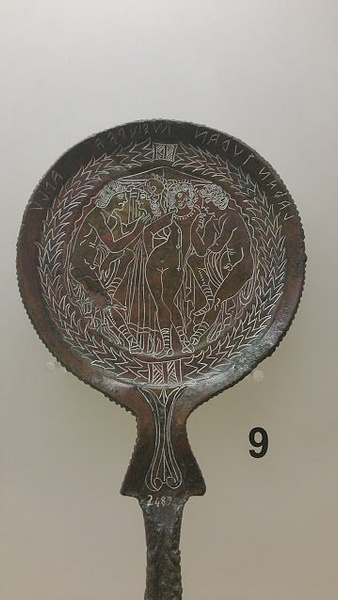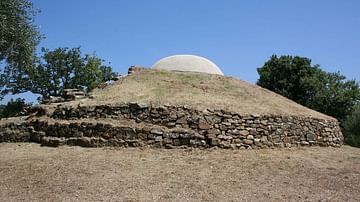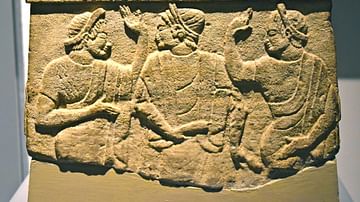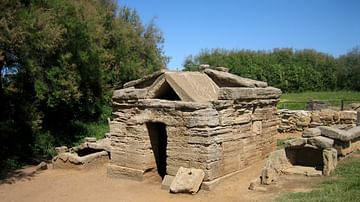The Etruscan civilization flourished in central Italy between the 8th and 3rd century BCE and produced distinctive art in the form of decorated pottery, figure sculpture, wall paintings, and the focus of this article, engraved bronze mirrors. Perhaps rather unfairly, the Etruscans long-held a reputation for effeminacy and as lovers of luxury; a portrait not coincidentally perpetuated by their conquerors the Romans. The high number of Etruscan-made bronze mirrors found in their tombs and elsewhere only fuelled this reputation as the ancient Mediterranean's great narcissists.

Function
Mirrors, known to the Etruscans as malena or malstria, were first produced in quantity from the end of the 6th century BCE right through to the 2nd century BCE. They were locally made in such Etruscan towns as Vulci, Tarquinia, Cerveteri and Chiusi, as attested by the large number of finds in those places.
Besides being an object of practical daily use, mirrors were a status symbol for aristocratic Etruscan women and appear on Etruscan tomb wall paintings often carried by a lady's maidservant. There is evidence, too, that they were used by some men if the fact that they were found in male-only tombs is an indicator. Mirrors were commonly given as part of a bride's dowry, and it is likely that these valuable objects, frequently decorated with great craftsmanship, also acquired a sentimental value. Mirrors have survived in such great numbers (over 3,000) because they were commonly laid with the deceased in Etruscan tombs, perhaps precisely because they were one of the objects the person had used daily throughout their lives. Curiously, many mirrors so placed in tombs have had their reflective surface made useless by the addition of an inscription: suthina, meaning 'of the grave.'
Design
Etruscan bronze mirrors, like Greek ones, were designed to be held in the hand using a single handle. The reflective side of mirrors was made by highly polishing or silvering the surface. From the 3rd century BCE more tin was used in the bronze alloy, which meant that the reflective surface gave a clearer image and was less prone to scratching and corrosion. Some mirrors from the 4th century BCE onwards were protected by a concave cover attached by a single hinge. The inside of the lid was often polished to reflect extra light onto the face of the user while the outside carried cut-out reliefs filled with a lead backing. A third type of mirror has the round reflective surface set into the lid of a wooden box.

The flat reverse side of bronze mirrors, if not left plain (half the surviving examples are so), was an ideal canvas for engraved decoration, inscription, or even carved shallow relief. The latter decoration technique is even more rarely inlaid with silver, as in an example now in the British Museum, London.
Handles were formed by casting the mirror with a tang at the bottom. This could then be inserted into a handle made from wood, bone, or ivory, but few such perishable pieces have survived intact. Some handles were painted or had carved relief scenes. Another type of mirror was produced from the 4th century BCE which had the handle cast along with the body. Many of this latter type have a bronze ram or hind's head decorating the end of the handle.
Decoration
The main purpose of Etruscan mirror decoration would seem to be just that, decoration. However, these valuable objects might also have become symbolic transfers of wealth and family ties, for example, when the bride and groom were from different clans. In the latter case, the decoration may have represented, either directly or metaphorically, the union of the heritage of two families. Scenes and the people in them are often helpfully identified by accompanying inscriptions around the mirror edge, and these sometimes even describe the owner, for example, 'I am the mirror of Larthi Puruhena' (Mi malena larthia puruhenas) or even the giver, 'Tite Cale to his mother gave this mirror as a gift' (tite cale:atial:turce malstria:cver). Around 300 mirrors have names inscribed on them, most being female, and so they are an important indicator of literacy amongst Etruscan women.

Some mirrors have scenes of wedding preparations, couples embracing or a lady in the process of dressing, but the most common subject for mirror decoration was mythology. Here mirrors illustrate the great influence of Greek culture on the Etruscans as the myths are, invariably, of Greek origin, even if they are sometimes given an Etruscan twist. Scenes are often framed by a border of twisted ivy, vine, myrtle, or laurel leaves.
Perhaps not surprisingly, myths which involved a degree of vanity or gods renowned for their physical beauty are particularly popular subjects. Thus we see scenes of Paris deciding which of the three goddesses are the most beautiful and plumbing for Aphrodite (for the Etruscans: Turan) ahead of Athena and Hera. Aphrodite, the goddess of love and beauty being attended to and beautified by her entourage is another common subject. The impossibly handsome Adonis (Atune) and favourite of Aphrodite, Zeus carrying off the attractive youth Ganymede (Catamite), Eos – the winged Dawn known for her love of handsome hunters, and that most famous earthly beauty of all – Helen of Troy, are all personas bound to inspire those who managed to pull themselves from the mirror's reflective side.





